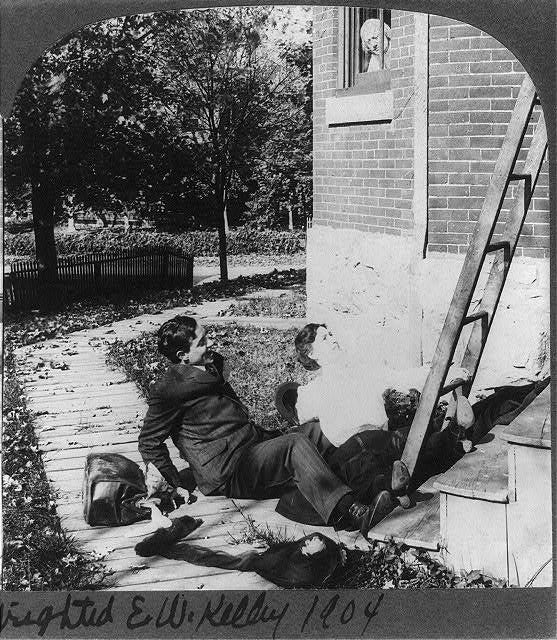An elopement and a missing American
Glasgow's Alfred Knowles seemed to work on some fascinating cases - but were they actually real?
Back in November 2022, I wrote about the Glasgow-based private detective Alfred Knowles and how his press adverts highlighted his skills and superiority over other investigators (see the article here). This story focused on Knowles’ work during the early 1880s, when he was based on Dundas Street, Glasgow. However, I have since researched further back, discovering his former office at 57 North Hanover Street in the late 1870s. Judging from the coverage of his cases in the Scottish press at this time, Knowles was a good publicist, who ensured that the papers were tipped-off about his more interesting cases.
In November 1877, for example, a story about him appeared in the Dundee Courier - well, it was about one of his cases, but, unusually for a news story, everyone in it was anonymous apart from the private detective. Either Knowles wanted to ensure that the focus remained on him, or it was a fictional case he had invented to make the papers interested. In the latter case, he didn't give the parties names in case they could be confused with a real individual.
A staged photo of an elopement. Was Knowles’ case of the aborted elopement equally staged, or rather, fictional?
The case involved a young woman from Glasgow's pleasant west end - the daughter of a 'gentleman of position'. She had started corresponding with a young Edinburgh man, and had fallen in love with him. Her parents did not approve of the relationship, and so the young man encouraged the girl to elope with him. Her father was suspicious and so notified 'Mr Knowles of the private detective agency, North Hanover Street', asking him to shadow the man whenever he turned up in Glasgow.
One Tuesday morning, both the girl's parents had to go out, and knowing this, Knowles had kept watch on their house. He duly saw the young man enter. Later, Knowles followed him to a restaurant, where he heard him tell a friend he had met that he and the girl planned to elope that evening, meeting at St Enoch Station to catch the 9.15pm train to London. Knowles immediately told the parents, and they met him on the station platform. When the romantic couple got out of a cab to get the train, they were cornered. Apparently, the girl was persuaded to go home rather than elope, and her lover promptly disappeared. This was a successful result, and, if real, it was understandable that Knowles wanted to publicise it; it could get him further business. If not real, it would still have the same result.
A press article early the next year was very different, but again seemed a bit suspicious. It involved a missing American - but although he was named, I have been unable to track him down, and the only mentions of him are in British newspapers at the time of his ‘disappearance’. As with the elopement of 1877, again, I wonder whether the case was a work of fiction simply designed to promote Alfred Knowles.
Knowles claimed to have been trying to find the man for 'some weeks', without luck. He was named as a Pennsylvania physician, Richard Alexander Robertson, who had been induced to visit Glasgow from the States back in February 1877. He had received a letter notifying him that he was the heir to a £10,000 estate, and that he needed to come to Scotland to claim it. He duly sailed across the Atlantic, and while staying in Glasgow, received a document in the name of the 'Probate Court, Hamilton', with a cheque from the National Bank of Scotland for the estate's residue - £9704 - post-dated to 23 December 1877.
Had Dr Robertson been left money held by the National Bank of Scotland? (image by Stephencdickson)
Solicitors in Hamilton named Murray & Davidson then apparently negotiated with him to pay a commission of 3s or 4s per pound, which Robertson allegedly did, paying the solicitors between £500 and £600. He returned to America, but in July 1877, was called back to Scotland 'in regard of the money coming due'. He then vanished into thin air, his wife in Pennsylvania hearing nothing else about him.
Knowles was duly commissioned to investigate, but all he found was that Murray & Davidson didn't exist, nor did the Hamilton Probate Court, and that there was no money in the National Bank of Scotland due to Dr Robertson. Knowles told the Dundee Courier that either swindlers were keeping Dr Robertson captive, or that they had killed him. That it might be a disappearance trick deliberately conjured up by Robertson himself was not, apparently, even considered. It was a complex but exciting story, involving Americans, money, and possible kidnapping: it was not the usual type of case investigated by British private detectives, and perhaps that is why I remain slightly unconvinced by it.
It was a valuable publicity tool for Knowles, however, and the story of the missing physician - as well as the earlier one about the eloping couple - duly made their way into papers in England after being published in Scotland, thus ensuring that Knowles' work would be read about beyond Glasgow.



